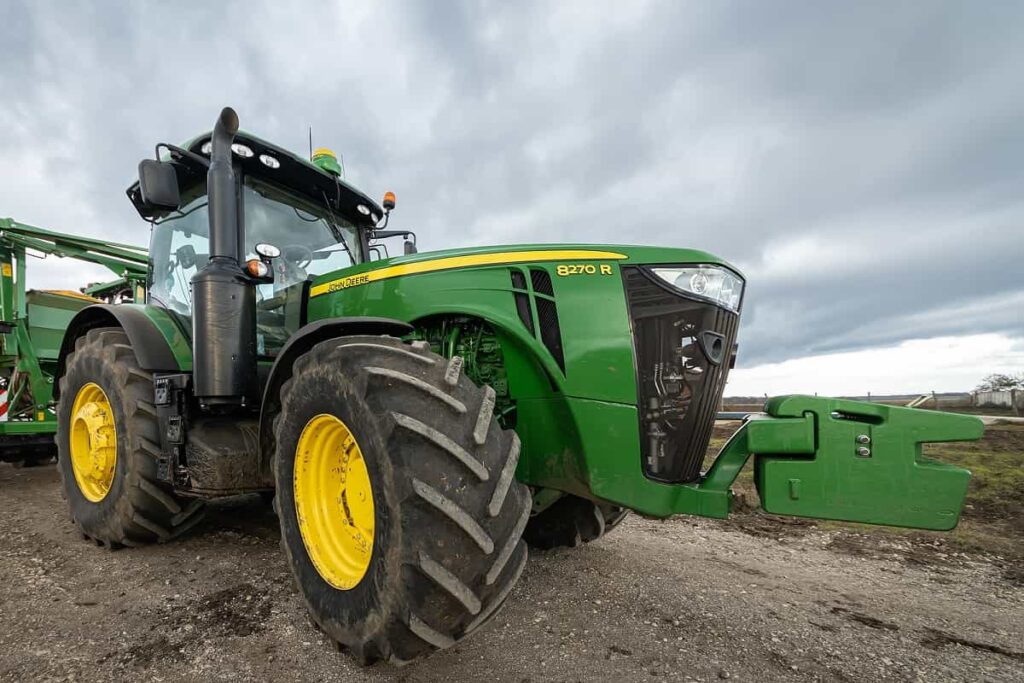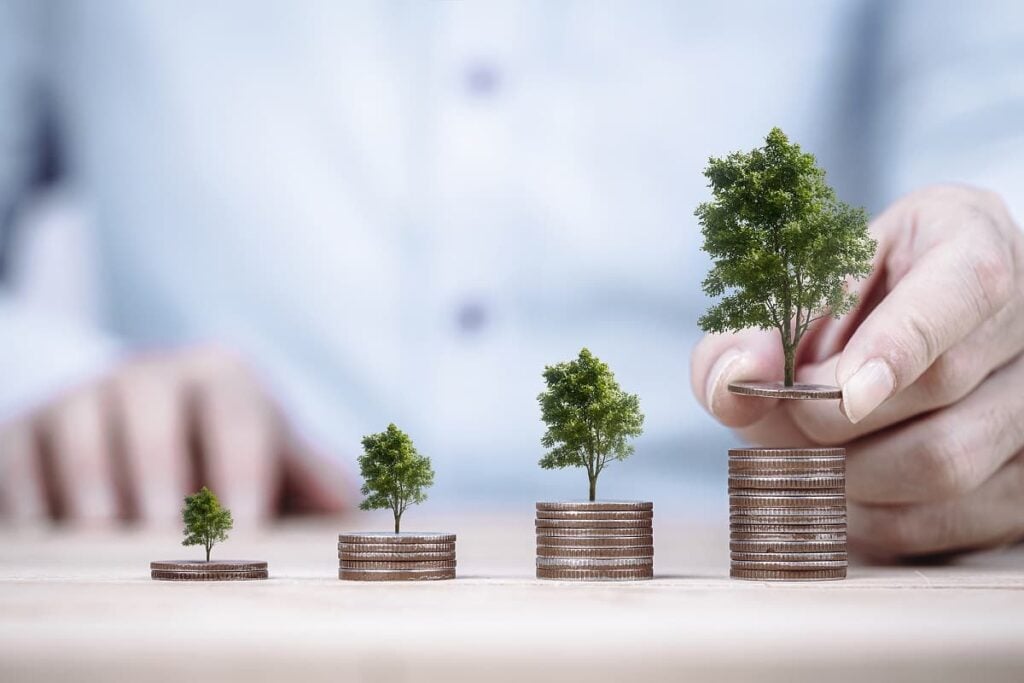Why Farmland Investing Makes Sense
Table of contents

The term “flight to quality” refers to the tendency of investors to move their money from high-risk assets to low risk-assets in times of turmoil. For example, the herd might exchange high-yield bonds and volatile tech stocks for the stability of gold or the Swiss Franc. The logic behind this transfer of assets is to reduce volatility which is synonymous with reducing risk. To understand what that means, think about how you feel when the stock market takes a dump and your 401K drops -30%. That feeling you get is caused by volatility. Sure, you could go to cash and completely avoid volatility, but then you only get the smallest of returns. In fact, you’ll lose money over time because inflation will eat away at your purchasing power.
As an investor, you always want to maximize your returns while minimizing risk. There’s a reason the “risk-free rate” pays so little. As risk increases, the likelihood of higher returns increases, and so does the likelihood of higher losses. One way to compare the risk-reward ratio of investments is by looking at the Sharpe Ratio. Sounds complicated, but it’s really quite simple. Divide the annual returns of an investment by the volatility of the investment. The higher number the better because it means you’re getting more return for less volatility. Now that we understand the importance of maximizing return and minimizing volatility, let’s take a look at farmland as an investment thesis.
Is Farmland a Good Investment?
The most basic financial advice individual investors will get from a financial planner is to allocate a certain percentage of your assets in stocks and bonds. The percentage in bonds is often said to mimic your age. At age 60, you’d have 60% of your assets in bonds and 40% in stocks. This basic advice is a great start, but investors should also consider other asset classes like real estate. If you have a mortgage with equity in your home, that counts as a real estate investment, but it’s also correlated to stocks and bonds. What you need is an alternative investment that isn’t correlated to stocks and bonds.
This brings us to investing in farmland. The below table was taken from a research note by Hancock Agricultural Investment Group that puts into perspective just how good an investment farmland has been over the past 40 years.

A good investment increases your return while decreasing your volatility. Over the last 40 years, farmland investments experienced higher returns than all asset class categories excluding small-cap equities. At the same time, farmland had much lower volatility than equities and bonds. The end result is a Sharpe Ratio that exceeds that of any other investment listed. Keep in mind that we’re talking about a 40-year time horizon here.
Another benefit of owning farmland as an alternative asset class is that it’s not correlated to other asset classes. This means that farmland income and capital appreciation happen independently of whether or not the stock market rises or falls.

While investing in farmland used to be accessible only to institutional investors, it’s now becoming accessible to accredited investors as well.
Why Invest in Farmland Now?
“Invest in land because they’re not making any more of it,” as the old saying goes. Only 7% of Earth’s land is suitable for cultivation, and most of the world’s productive arable land is already in crop production. Buying farmland has historically been the forte of farmland owners who are less concerned with real estate investing and more interested in crop yield. Around 98% of the farmland in the United States is not owned by institutional investors, but that’s changing as farmland assets are becoming increasingly popular as a valuable addition to any investment portfolio.
If you’re looking for passive income, a farmland investment can provide bond-like income streams from contractual lease obligations and the sale of commodities. When it comes time to exit, land value appreciation can provide capital gains similar to the capital appreciation of a stock. Arable land can also provide a strong hedge against inflation as both the cash yield and the land value of a real asset is linked to inflation measures. For example, when inflation rises, commodity prices also tend to increase, leading to a higher cash yield from the land.
There are a few publicly traded real estate investment trusts (REITs) for farmland, but those pale in comparison to the $2.5 trillion worth of U.S. farmland that’s being used to feed people around the globe. Since farmland sounds like such a compelling asset class, let’s take a look at some actual farmland projects on offer from a fintech startup called FarmTogether.
Farmland Investments From FarmTogether
Founded in 2017, San Francisco startup FarmTogether took in several million in seed funding to grow their farmland investing platform. From row crops like wheat, corn, and soybeans, to permanent crops like tree fruits, nuts, citrus, grapes, FarmTogether selects the best projects to offer on their platform for accredited investors with minimums starting at around $10,000. Thousands of accredited investors now use the platform to invest in close to a dozen projects that have been sourced. We sat down to talk with Artem Milinchuk, CEO and Founder of FarmTogether, to discuss the massive opportunity for farmland investing.
The Farmland Opportunity
The average age of a farmer today is 60 years old, which means that a lot of farmland will be changing hands soon. (It is anticipated that between $240 billion and $1 trillion of farmland will change hands in the next ten years.) With 97% of all farms being family owned, it’s up to the next generation to take over the reins. Sure, you may be rolling coal in your Cummins diesel and occasionally helping out Dad on the farm, but are you really willing to take over when he passes away? Long hours, unpredictable income, extremely hard work, a challenging labor market, these are all challenges that face the next generation of millennial farmers. This means that when farmland changes hands, some stakeholders will want out.
At the same time, there will be tremendous opportunity here. The “we always did it that way” farming methods will be replaced by more modern methods of farming like autonomous farming equipment or agricultural robots. Modernization requires capital, so what we need is a market that can provide both capital and liquidity.
When we talk about farming on arable land, we can divide this into two broad segments:
- Row crops – corn, wheat, soybeans
- Permanent crops – citrus, tree fruit, nuts, olives
Around 70% of all harvested crop farmland is in parcels of $10 million or less, meaning the entire farmland space is extremely fragmented. There is an opportunity to consolidate and enjoy economies of scale. As for permanent crops, these are more high-value products that also come with increased risk. One hailstorm can wipe out your cherry crop in twenty minutes. A new stink bug being studied by the University of Oregon is decimating pear yields as they scramble to figure out a solution. Nobody gets to see how the sausage gets made, but it’s not easy. That’s why you need a partner to invest in farmland who knows how to mitigate these risks.
An Example of Farmland Investing
Mr. Milinchuk talked about how his team has collective experience deploying over a billion dollars in agriculture and farming over the years. Right now, they’re focusing on West Coast opportunities where mostly permanent crops can be found. That’s because the FarmTogether team has a great deal of in-house expertise in permanent crops, along with a really good understanding of water, something that’s critically important in places like California – where FarmTogether’s latest project is.
Jupiter Farm
As the oldest tree food, walnuts are pervasive in California’s Central Valley which produces almost 100% of US walnuts and 75% globally. Walnuts and almonds are the two most consumed tree nuts and comprise around half of global tree nut consumption. One place where both are grown is on Jupiter Farm, a turnkey walnut and almond farm with 54 acres of mature walnuts (the premium Chandler variety) and 16 acres of Independence almonds planted in 2019. (The Independence variety is self-fertile and does not require bees for pollination resulting in lower farming costs over the life of the investment.) The property has prime soils and abundant water with riparian water rights to the Tule River and high yielding groundwater wells. A firm called Green Leaf Farms will run the operation along with over 3,000 acres they’re already running in the area. (They have been farming for institutional clients since 1972.)
As mentioned before, you’ll need to be an accredited investor to participate in the deal. The minimum to participate is $15,000 which will give you around 0.06% of the total offering ($15,000 / $2,369,000) or about 0.44 acres of farmland that you will legally own. (The property is owned by an LLC which you have part ownership in.) The $2.4 million is a loan being made to the operators of the property with a loan-to-value (LTV) of around 50%. The return on your investment comes in two parts – 70% operational income and 30% land value appreciation. The value of the property is expected to increase 3.25% per year due to yield improvements, growing demand for almonds and walnuts, and long-term structural farmland trends.
Here are what cash flows look like for an investment of $15,000:

A better way to think about this is in terms of income vs. capital appreciation. Income reflects the trees bearing nuts every year, and this grows as the new almond trees come online. If all goes well, every year you will see a higher income stream which helps offset inflation. (This is why we have most of our capital in dividend growth investing right now.) At the end of the property’s target hold period, investors receive their share of capital gains from the sale of their farm along with their original investment.
Jupiter Farm is an 8-year hold investment with an option for a 1-year extension to ensure they have enough time to get the appropriate sale price for the property. Every year there will be a liquidity window in case you need an early exit, but try not to. As with any investment, you need time to make money.
Why FarmTogether?
When you invest on the FarmTogether platform, you’re purchasing shares in an LLC. You become a fractional owner of the farmland and are entitled to returns from its operation. What you get with those fees are subject matter experts who perform due diligence on potential investments such as industry analysis, soil, tissue, water rights, on-farm equipment and farm’s potential for capital improvements. FarmTogether administers and manages all properties so you’ll receive regular updates on your farmland investments, including refreshed key performance indicators on productivity, photos and videos. Fees vary by offering. For example, here are the fees for the aforementioned Jupiter Farm project.

There’s another benefit attached to the work FarmTogether is doing. When they take on various projects, they’re often able to increase the output or yield by doing things the farmer already knows about but lacks the capital to execute on. For example, the McLeish Farm was a sale-leaseback opportunity with 130 tillable acres and 24 pasture acres at purchase. The farmer no longer wanted to live on the property, so the house and grazing pasture were removed resulting in a nearly 15% increase in crop productivity.

We’ve talked before about how much agricultural output needs to increase to feed all the hungry mouths as the planet expands. Increasing yield from exiting farmland footprints is one way. The other is to begin partnering with agtech firms that can increase yield across multiple properties under the FarmTogether umbrella. These are just some of the benefits that can be realized as the platform starts to achieve some economies of scale
Conclusion
Farmland ownership isn’t just about making a land investment for capital appreciation, it’s also a responsible investment. Investing in agriculture will do more to help feed the starving children in Africa than donating to some high-overhead charity with loose purse strings. Farming is a noble tradition that’s been conducted for centuries, and you’ll feel a whole lot better owning a tangible asset that helps put food on the table. Literally.
Sign up to our newsletter to get more of our great research delivered straight to your inbox!
Nanalyze Weekly includes useful insights written by our team of underpaid MBAs, research on new disruptive technology stocks flying under the radar, and summaries of our recent research. Always 100% free.















